No Mere Nostalgia: The Original Clash of the Titans
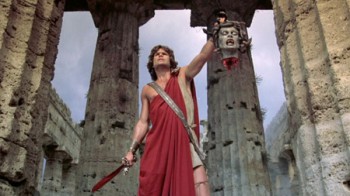 On April 2nd, “Titans Will Clash!” Which is perhaps the worst tag-line I’ve seen since “The Story That Won’t Go Away” for JFK. I wonder why the tag-line on director Louis Lettier’s previous film wasn’t “This Summer, The Hulk Is Incredible!”
On April 2nd, “Titans Will Clash!” Which is perhaps the worst tag-line I’ve seen since “The Story That Won’t Go Away” for JFK. I wonder why the tag-line on director Louis Lettier’s previous film wasn’t “This Summer, The Hulk Is Incredible!”
And the Titans will also clash in 3D. But not real 3D; this is a post-production fix designed to cash-in on the success of another 3D movie. Clash ‘10 wasn’t shot with the extra dimension in mind, so don’t expect me to shell out extra cash for the polarized goggles.
I would feel a bit easier about the upcoming re-make of Clash of the Titans if it weren’t for the attitude of some online movie sites and critics who seem to take pleasure in putting down the 1981 original in their anticipation of the new film. I should feel nothing but excitement; who am I to object to Greek myth and big beasts on the silver screen? But I have this discomfort with those critics who normally object to re-makes but somehow feel that the Ray Harryhausen classic is going to get improved in a re-do because the original is only “cheesy nostalgia.”
No. It’s. Not.
Even when it came out in 1981, Clash of the Titans was already a “nostalgia” film. Visual effects processes were changing radically from the influx of science-fiction and fantasy films in the late-1970s. Harryhausen’s methods were still the same as when he worked on The 7th Voyage of Sinbad in 1958, and he did most of the hands-on work himself. He had a few assistants on Clash of the Titans, such as skilled animator Jim Danforth, but it was still a small effects group compared to the enormous teams and VFX houses that have taken over the business. Harryhausen quietly retired after Clash of the Titans, knowing a new era had come. But none of this stopped people from seeing the film in droves and loving it.
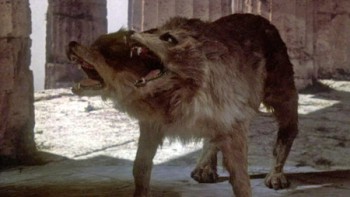 And still loving it—because Clash of the Titans is a truly great film that doesn’t require any nostalgia to make it work. It lives on its own. I still thrill to it, not merely because I loved it as a child and that it is the only Harryhausen film that I was old enough to have seen first-run in a theater, but because it is made with such detail, love, and sincerity for its material. There are many films I love as a child that do nothing for me today except make me shrug and marvel at how tastes change. Clash of the Titans, however, only seems to get better each time I see it. It transports with its fantasy, doing what mythology and fantasy should do. If it doesn’t adhere to the letter of the Greek myths, it is still the best screen interpretation of the religion of the Hellenes; it looks the way the ancients must have imagined their own supernatural world.
And still loving it—because Clash of the Titans is a truly great film that doesn’t require any nostalgia to make it work. It lives on its own. I still thrill to it, not merely because I loved it as a child and that it is the only Harryhausen film that I was old enough to have seen first-run in a theater, but because it is made with such detail, love, and sincerity for its material. There are many films I love as a child that do nothing for me today except make me shrug and marvel at how tastes change. Clash of the Titans, however, only seems to get better each time I see it. It transports with its fantasy, doing what mythology and fantasy should do. If it doesn’t adhere to the letter of the Greek myths, it is still the best screen interpretation of the religion of the Hellenes; it looks the way the ancients must have imagined their own supernatural world.
Perhaps the critics should sit down and watch the original Clash of the Titans again before seeing the new one. I think the reason that they’re making their claims that it’s “just a piece of nostalgia” is that they really haven’t watched it recently. I promise them that a fresh viewing will change their minds.
Harryhausen and Charles H. Schneer, his producer since It Came from Beneath the Sea, had scored two major successes with Sinbad movies during the 1970s, The Golden Voyage of Sinbad (1974) and Sinbad and the Eye of the Tiger (1977). The second one, however, was not one of their higher quality outings, something of which Harryhausen was well aware. The choice to move back to Greek mythology, which had worked so well with 1964’s Jason and the Argonauts, was now a natural one. Just as The Golden Voyage of Sinbad had repeated the magic of The 7th Voyage of Sinbad, so would Clash of the Titans repeat the magic of Jason and the Argonauts.
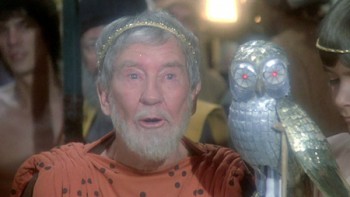 The source material for Clash of the Titans is the myth of Perseus, which is one of the oldest traceable stories in the canon of Greek heroes. Harryhausen and screenwriter Beverly Cross made many changes to the story, although the core of Perseus questing to slice off the head of the Gorgon Medusa and his encounter with the Kraken remain. Perseus’s original reason for fetching Medusa’s petrifying head was because King Polydectes tricked him into making the vow so he could get rid of the boy and clear the path toward marrying Perseus’s mother, Danae. This is similar to Jason’s catalyst for going after the Golden Fleece in Jason and the Argonauts, and perhaps this is one reason that Clash of the Titans creates a new motivation, tying the quest of the Gorgon directly to the Kraken and Andromeda, which is a late episode in the myth that isn’t tied in with anything that occurs previously. The goddess Thetis is made into Perseus’s principle adversary (although not a villain, since that idea goes against the style of the Greek religion—no god is specifically “good” or “evil”), and Athena moves into the background. The script also gives the mount Pegasus to Perseus, even though Pegasus springs from the headless torso of Medusa in the myth, and it is Bellerophon who tames and rides the winged horse. However, there is a history in Renaissance art of depicting Perseus as Pegasus’s rider, so this has some genuine precedent.
The source material for Clash of the Titans is the myth of Perseus, which is one of the oldest traceable stories in the canon of Greek heroes. Harryhausen and screenwriter Beverly Cross made many changes to the story, although the core of Perseus questing to slice off the head of the Gorgon Medusa and his encounter with the Kraken remain. Perseus’s original reason for fetching Medusa’s petrifying head was because King Polydectes tricked him into making the vow so he could get rid of the boy and clear the path toward marrying Perseus’s mother, Danae. This is similar to Jason’s catalyst for going after the Golden Fleece in Jason and the Argonauts, and perhaps this is one reason that Clash of the Titans creates a new motivation, tying the quest of the Gorgon directly to the Kraken and Andromeda, which is a late episode in the myth that isn’t tied in with anything that occurs previously. The goddess Thetis is made into Perseus’s principle adversary (although not a villain, since that idea goes against the style of the Greek religion—no god is specifically “good” or “evil”), and Athena moves into the background. The script also gives the mount Pegasus to Perseus, even though Pegasus springs from the headless torso of Medusa in the myth, and it is Bellerophon who tames and rides the winged horse. However, there is a history in Renaissance art of depicting Perseus as Pegasus’s rider, so this has some genuine precedent.
Harryhausen also packed in more monsters to the story—they’re what we’re paying to see, right? He already had Pegasus, Medusa, and the Kraken. The awesome Kraken is one of the special-effect master’s most unusually designed creatures, taking characteristics of King Kong and the Ymir from Harryhausen’s earlier film, 20 Million Miles to Earth, and giving them an aquatic twist. The new creatures to the tale are a varied lot: the twisted humanoid Calibos becomes a major villain who does the dirty work for Thetis, and is a rare combination of live-action performance and stop-motion animation. The three-headed Hound of Hades Cerebus loses a head (too difficult to animate) and is retitled “Dioskilos.” A giant vulture serves Calibos for no reason except that a giant vulture looks magnificent swooping down from the night sky and fits Calibos’s funereal swap dwelling. Huge scorpions born of Medusa’s blood make life tough for the heroes even after the gorgon’s death. Oh, and a cute mechanical owl named Bubo entertains the kiddies. I genuinely like Bubo; his mechanical movements are beautifully executed, and the practical prop version meshes well with the animated one. Harryhausen designed Bubo before Star Wars came out, so despite claims to the contrary, the whirling mecha-owl isn’t a copycat of R2D2.
None of the SFX sequences disappoint. The roping of Pegasus and the final battle, which involves animating Pegasus, Bubo, the Kraken, Medusa’s head, and a miniature Perseus, are impressive work at the level of Harryhausen’s best. But it’s the Medusa encounter that tops them all—tops everything else in Harryhausen’s career. It’s his Sistine Chapel, in my opinion.
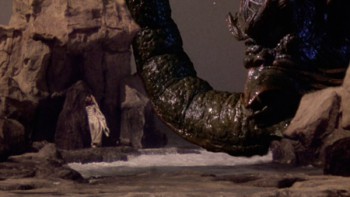 In a featurette for the new Clash of the Titans, the filmmakers seem proud that their Medusa is fast-moving instead of the slow one from the original. Uhm, I think that was the whole point. The Medusa scene isn’t a fight, it’s a suspense sequence, and the slow and tense winding movement of the snake-haired monster, punctuated with the hideous rattle of her tail, create an engrossing experience. Harryhausen not only crafted great animation in this scene, but superb atmosphere with the use of the claustrophobic temple set, shadows, and the flickering hell-lights of the torches. Everything about the sequence works towards tightening the tension until the unleash when Perseus whacks off the Gorgon’s head. The details in these final seconds—Medusa’s claws scraping white marks across the granite of a pillar, the writhing serpentine torso, the final “death-rattle”—are superlative special effects and movie magic. And the movie tops it off with Perseus staggering into the light to hold up Medusa’s severed head toward heavens, and Zeus cries out, “Find and fulfill your destiny.” This is one of my favorite of all movie moments.
In a featurette for the new Clash of the Titans, the filmmakers seem proud that their Medusa is fast-moving instead of the slow one from the original. Uhm, I think that was the whole point. The Medusa scene isn’t a fight, it’s a suspense sequence, and the slow and tense winding movement of the snake-haired monster, punctuated with the hideous rattle of her tail, create an engrossing experience. Harryhausen not only crafted great animation in this scene, but superb atmosphere with the use of the claustrophobic temple set, shadows, and the flickering hell-lights of the torches. Everything about the sequence works towards tightening the tension until the unleash when Perseus whacks off the Gorgon’s head. The details in these final seconds—Medusa’s claws scraping white marks across the granite of a pillar, the writhing serpentine torso, the final “death-rattle”—are superlative special effects and movie magic. And the movie tops it off with Perseus staggering into the light to hold up Medusa’s severed head toward heavens, and Zeus cries out, “Find and fulfill your destiny.” This is one of my favorite of all movie moments.
Along with all the beasties, Harryhausen execute a fine non-animated effects scene near the opening when the Kraken creates a tidal waves to destroy the city of Argos. The miniature work here is about the same level as what most genre films were doing at the time, even considering the phenomenon of Star Wars. It can’t match the destruction of Krypton in Superman, but at least it doesn’t go on so blasted long.
The dramatis personae has the biggest names ever to appear in the Schneer-Harryhausen canon, boasting major international film and stage actors in the supporting cast. The Golden Voyage of Sinbad has a better overall set of performances, but you can’t help but feel impressed with Laurence Olivier (Zeus), Maggie Smith (Thetis), Siân Phillips (Cassiopeia), Flora Robson, Freda Jackson (Stygian Witches), and Ursula Andress (Aphrodite). Best of all is the stateside casting coup of the beloved Burgess Meredith, who gives the best turn of all as the wise old mentor character, Ammon the playwright.
As the lead, Harry Hamlin is adequate as Perseus and projects charisma even though his performance is a bit stiff. The female lead, Judith Bowker, is simply stunning as a girlish Andromeda with completely captivating eyes. She shows great strength in the role, and it seems a bit strange that at the end she has to turn into a standard damsel in distress.
Clash of the Titans has a few problems with its plot, some of which doesn’t make much sense in the “connect-the-dots” fashion that often plagues quest stories. Why the city of Joppa fears Calibos so much when he lives in a swamp commanding five guys armed with clubs, and what his “curse” entails, is never sufficiently explained. The way the gods meddle and then abruptly seem powerless to stop certain actions is a weakness inherent in Greek mythology, but it really feels strange on the screen. And why does it seem that the entrance to Hades and river Styx with Charon the Ferryman is merely a day’s ride from Joppa? No, make that a day’s walk, since Perseus manages to stumble the whole distance half-conscious just before the Longest Day and the sacrifice of Andromeda. It just seems an inconvenient place to build a city, that’s all. The film does occasionally reveal its lower-budget (although this was the most expensive of all Harryhausen’s films): the crowds appear rather thin, for example.
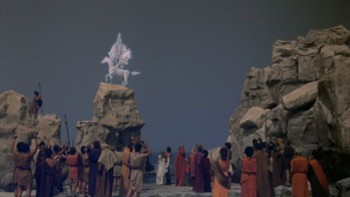 That Laurence Rosenthal somehow didn’t turn into one of the foremost composers of the decade based on what he did in Clash of the Titans completely mystifies me. The Harryhausen-Schneer canon has an impressive history of major film composers: Bernard Herrmann, Miklos Rozsa, Jerome Moross, Laurie Johnston. Rosenthal is the “smallest” of all these names, with few other major films to his credit, but you sure wouldn’t know it from the epic music in the movie. It’s actually the biggest score for any of Harryhausen films, and if you don’t feel a surge of passion at the conclusion when Pegasus erupts from the ocean to alight triumphantly on the rocks while the heroic Main Theme explodes on the soundtrack, then you’re either deaf or dead.
That Laurence Rosenthal somehow didn’t turn into one of the foremost composers of the decade based on what he did in Clash of the Titans completely mystifies me. The Harryhausen-Schneer canon has an impressive history of major film composers: Bernard Herrmann, Miklos Rozsa, Jerome Moross, Laurie Johnston. Rosenthal is the “smallest” of all these names, with few other major films to his credit, but you sure wouldn’t know it from the epic music in the movie. It’s actually the biggest score for any of Harryhausen films, and if you don’t feel a surge of passion at the conclusion when Pegasus erupts from the ocean to alight triumphantly on the rocks while the heroic Main Theme explodes on the soundtrack, then you’re either deaf or dead.
To close my look at one my favorite movies (and I could go on a lot longer, believe me), I’ll confess that I get misty-eyed during Laurence Olivier’s final speech as Zeus over the field of constellations in the night sky. It sounds as if it is Ray Harryhausen’s farewell as Zeus predicts that the great stories shall never die because they live in the stars, and “the stars will never fade . . . never . . . they will burn until the end of time. . . .”
Returning to—(Wait, what year is it? Let me check the calendar)—2010 C.E. . . .
In spite of the annoying promotional materials and silly statements from critics who should know better, I am looking forward to new Clash of the Titans on April 2nd and will walk into the theater with as open a mind as a Harryhausen fanatic can. At the very least, no matter how it relates to the classic, it’s still epic fantasy of the sword-and-sandal genre loaded with tons of monsters. You can expect a review on the Tuesday after the film comes out. But not of the 3D version.
For those of you interested, I’ve also reviewed the novelization of the original movie.
[…] . . . I’m not here today to review the original Clash of the Titans. I’m planning to do an extensive analysis of it later this month, but for the first post of 2010 I’ve decided to take a different tactic as a warm-up and approach […]
[…] 21, 2010 Recently Black Gate ran a wonderful article defending the original Clash of the Titans, or, more accurately, expaining why the original Clash of the Titans does not need defending, […]
[…] may not believe this, based on other things I’ve written at this site, but I walked into my local movie theater showing the re-make of […]
[…] often said that seeing Clash of the Titans (this one, not that one) when I was eight years old was what made me fascinated with the ancient […]
[…] this year, I marched stolidly at the front of a phalanx to defend the original Clash of the Titans right before its re-make was about to hit theaters. I found the re-make more palatable than I […]
[…] this year, I marched stolidly at the front of a phalanx to defend the original Clash of the Titans right before its re-make was about to hit theaters. I found the re-make more palatable than I […]
[…] In the middle of mad speculation and analysis from the new Bat-info Warner Bros. and Legendary Films poured on us, the studio and production company also sneake out the trailer for another of their 2012 releases: Wrath of the Titans, the sequel to the 2010 re-make of Ray Harryhusen’s Clash of the Titans. […]
[…] Harryhausen’s life to Black Gate’s readers. You know him. You love him as much as I do. Seeing Clash of the Titans in second grade changed my life: not only did it take a kid who loved dinosaurs and made him into […]